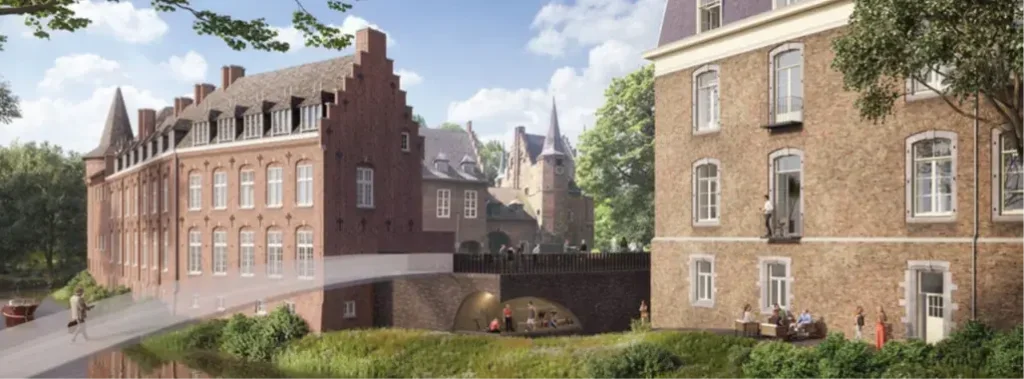
Townhouses. Canals. Vermeers. For over a century, what we think of as Dutch tourism has seared itself into the mind as vividly as Italian piazzas or English country lanes. As long ago as 1901, local hoteliers gathered to sing the delights of Amsterdam, and a few decades later they were explicitly marketing the town as a centre for art and culture. Even in 1940, with Europe aflame and German tanks grumbling nearby, one optimistic Dutch official declared: “There are still many tourists that are ‘crazy’ for historical places and buildings.”
Today, the city has an estimated 7,000 officially recognised historical buildings and almost 40,000 hotel rooms, according to Statista, making the erstwhile home of Rembrandt and Anne Frank a jewel. Yet, while Amsterdam remains as frantic with tourists as ever (more than 14.6 million visitors stayed in hotels and other short-term accommodations in the third quarter of 2022 according to the Holland Times), not everyone is happy with the influx. In December of the same year, the city launched a campaign to ‘stay away’ from drugs and sex, and local authorities have implemented legislation making it far harder to build new hotels along the city’s infamous waterways.
To an extent, these worries are understandable. Alongside its more wholesome architectural and cultural reputation, Amsterdam is equally famous for cannabis and prostitution. And as the country’s largest city – in one of the most densely populated nations in Europe – social problems are bound to follow. With Amsterdam seemingly happy to relinquish its crown as a tourist’s top choice, this leaves space for other parts of the kingdom to shine. They may not be as fashionable just yet, but cities like Haarlem and Rotterdam, to name a few, are exploiting their robust infrastructure and convenient locations to appeal to suitors from across hospitality.

Pandemic recovery
All things considered, Dutch hospitality had a pretty good pandemic. Of course, the country suffered like the rest; only seven million people visited in 2020, a significant fall from 20 million foreign tourists in the year before, according to figures from Statista. Yet, Technavio forecasts the hospitality market share in the Netherlands will grow by $5.3bn by 2026.
As Jurrian Dompeling explains, a large part of this resurgence can be chalked down to the resilience of the Dutch themselves. The senior vice-president at JLL notes that throughout the pandemic there was careful collaboration between banks and landlords to forestall the kinds of bankruptcies and fire sales that stalked hospitality elsewhere, leaving owners and operators in a good position to recover. Other strengths of Dutch hospitality can plausibly be seen on a national scale. Consider the country’s location. Less than 165 miles wide, it is crisscrossed by motorways linking Belgium, Germany and France, meaning Dutch hotels are easily accessible by car from dozens of important foreign cities. Public transport is excellent there too – from the world-class Schiphol Airport to trains that arrive on time in over 90% of cases, as reported by RTL Nieuws.
Beyond these hard-nosed practicalities, there are plenty of sentimental reasons to love the country too. Gems of the Dutch Golden Age, Utrecht and Maastricht, offer plenty for admirers of gaunt waterside mansions, while the thrilling modernist towers found in The Hague are ideal for more contemporary sensibilities. It may be one of the most urbanised countries on Earth, but Stephan Stokkermans is equally keen to draw attention to his nation’s rural pleasures. “We market ourselves as the beach of Amsterdam,” explains Stokkermans, the managing director at the Grand Hotel Huis ter Duin, a five-star property overlooking the North Sea. “We try to position ourselves as an alternative for those who don’t necessarily have to be in the centre of those big cities.”
And why not? Spend time exploring the Dutch countryside and its bounties will unfurl themselves like tulips in the spring. Apart from Stokkermans and his hotel in the dunes, the Netherlands is abundant with lakes, forests and swamplands. It helps, too, that the country is simply so small. On a good day, you can drive between most cities in less than an hour, making the Netherlands an easy place to uncover even on a short break.
Escape to the country
Expected the welcome guests towards the end of this year, Kasteel Gemert Eindhoven promises to offer everything you’d expect in a slick European hotel – except it is developed out of a 14th century castle. Complete with turrets and courtyards, it will provide guests with two restaurants and a bar, a spa and indoor pool. When they tire, visitors will be able to retreat to one of 56 elegantly decorated guestrooms, filled with modern amenities yet sensitively decorated in touch with the building’s past. Yet, despite its impressive history, it’s the choice for this location that is strikingly important. Instead of being in Amsterdam, Kasteel Gemert Eindhoven, part of Hilton’s Curio Collection, is actually in the suburbs of Eindhoven – a city perhaps most famous for being flattened by the Luftwaffe, is now a major industrial centre. And the Hilton is not unique in its decision to look beyond the capital. With large swathes of Amsterdam off limits to new hotels and locals increasingly exhausted by foreigners, investors are setting their eyes on other places instead.
Certainly, this is clear from the numbers. According to work by THP, there are over 40 new hotels slated to open between 2021–24 in the Netherlands, spread across towns as distinct as Breda and Rotterdam. That’s shadowed by moves across particular brands. In 2022, for example, Marriott opened open two properties in The Hague. Not to be outdone, IHG will unveiled a new Kimpton in the heart of Rotterdam last year.
$5.3bn
The forecasted growth in hospitality market share in the Netherlands by 2026. Technavio
As this torrent of international branding implies, Dompeling argues the shift is more than purely geographical. Rather, he suggests it’s visitor demographics that are changing too, with curious tourists starting to venture further from the Rijksmuseum and Vondelpark for their holidays. “There have been hotels outside of the bigger cities that have been taking advantage of that strong domestic and German demand,” he says, “and [they] have actually reported pretty good numbers”.
Dompeling’s reference to German tourists is far from incidental. Boasting higher disposable incomes – and with affluent towns like Aachen or Bonn just across the border – it makes sense why so many Germans would be keen to explore more of what the Dutch have to offer. In a similar vein, both Dompeling and Stokkermans describe how owners are rushing to develop specific new concepts for every kind of traveller. For a country with one of the biggest industrial bases in Europe – home to several important banks and nine companies in the Fortune Global 500 – business is unsurprisingly a key focus here. At the Grand Hotel Huis ter Duin, Stokkermans suggests it is the property’s 22 meeting spaces that have played a large part in the recovery after the Covid slump. And though it may not be a purely Dutch phenomenon, Dompeling says that so-called ‘experiential hospitality’ is rising in popularity too. Just a cursory glance online makes it clear what he means, with glamping sites and isolated seaside studios just some of the options available for adventurous visitors.
A different kind of tourism
With so much activity happening across the country, it would be wrong to forget about Amsterdam entirely. Residents and officials may be grappling with how to stop their city from becoming a northern Venice, but that hardly means hospitality is disappearing.
On the contrary, you get the impression that hoteliers are instead opening more sophisticated properties with hopes to seduce the culturally minded travellers – and squeeze out those concerned with the Red Light District. A case in point is the Anantara. Opened in 2022 at a prime location opposite the Royal Palace, it offers a champagne bar and a restaurant overseen by a Michelin-starred chef. At the same time, the local government is adding on its own pressure, increasingly only issuing new permits to hotels that can prove their sustainability credentials. In short, if the dominance of Amsterdam has dampened, the lull of the pandemic has arguably given Dutch hoteliers an opportunity to reflect on what they want their industry to actually look like.
With Amsterdam now focused on what Dompeling calls “different kinds” of tourism, Stokkermans hints that insiders across the country are having similar conversations. “We were forced to look at different ways of working,” he says, noting that at his property, changes are afoot everywhere, from investing in staff to environmentalism. Stokkermans is predictably optimistic about tomorrow. “I think that when we have recovered from the current situation,” he says of Europe’s ongoing energy crisis, “we have a brighter future ahead of us, because we are able to shift to what this new society needs from us.” It’s a fair conclusion – especially if the Dutch can feel more comfortable in their own towns, as the tourists don’t seem to be slowing down.






